



Organic Acid-Based Products – Market Evaluation and Technical Comment
An overview of some acidifiers currently available on the market by Angela Riemensperger (Product Manager for Biomin), demonstrating the growing importance of this group of products.While the market is saturated and the demand for top quality poultry and pork in industrialised countries is more or less stable, improving living standards in other countries and an increase in the worldwide population results in a steadily increasing demand for poultry and pork meat. This together with the ban of antibiotics to secure the supply of safe food is expected to result in an increased demand for animal feed additives. Especially the ban of antibiotics within the EU has moved acidifiers in the centre of attention, as they are the next most adequate alternative to the use of antibiotics. However, in general, the market seems to shift more and more from the usage of pharmaceutical products to the usage of natural feed ingredients not least to gain – after a number of food scares worldwide – back the consumers’ trust in animal products.
Single organic acids are used as feed preservatives for a long time. The most popular single acids used are formic and propionic acid. However, the usage of organic acids as feed additive started to become popular in the last decade of the 20th century and research on the usage of acidifiers was boosted in the late 1990s and the beginning of 2000 due to the upcoming ban of antibiotics within the European Union.
Research done on the usage of organic acids as feed additive showed that using organic acid blends consisting of various organic and inorganic acids instead of single organic acids enhances the positive effects above those that can be achieved by using single acid products. Therefore, most organic acid–based products contain organic acid blends instead of using single acids to exert even stronger effects on animal performance.
Out of a selection of nearly 300 products currently available at the market, only around 38 per cent are based on a single acid. Most products are based on organic acid blends containing two or three acids, while a combination of more than three products is not very common (Figure 1). Numerous organic acids besides formic and propionic – the most commonly used acids – are used as shown in Figure 2. However, the most commonly used besides formic and propionic acid are citric and lactic as well as sorbic, malic, acetic and fumaric acids, while benzoic, butyric, tartaric and sorbic acids are not commonly used. However, the effects seen when using organic acids highly depend on which organic acid is used and at what inclusion level the acids are used. Furthermore, for preserving purposes, inclusion levels of organic acids are in general lower than for performance promotion.

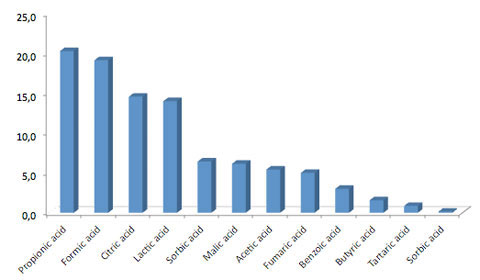
In about 30 per cent of the products, organic acids are combined with salts of organic acids. Most commonly used are ammonium formate and ammonium and calcium propionate, salts of formic and propionic acids (Figure 3). In most cases (around 67 per cent) only one salt of an organic acid is included as shown in Figure 4. To a lesser extent (26.5 per cent), two different salts organic acids are included, while the usage of three or more salts of organic acids within one product is not common.
Including salts of organic acids in acid–based products has the advantage that salts of organic acids are easier to handle as they are less corrosive compared to the liquid organic acids and more soluble in water than some liquid organic acids. Furthermore, salts of organic acids are in general odourless – a factor, which is more an issue in the feeding of pigs than poultry, as pigs react more sensitive to odours than poultry. However, salts of organic acids do not reduce the pH to the same extent as organic acids. This is due to the replacement of the H+ ion by other cations such as Ca2+, NH+ and NH4+.
The reduction of the pH plays a key role in the use of acidifying products. The proportion of dissociated acids increases with increasing pH. Only non-dissociated acids are able to penetrate the bacteria cell wall by traversing the membrane and disrupt the processes of certain types of bacteria, resulting in the inhibition of their growth or even cellular death. This means that, if the pH does not decrease to the same extent as it does by using organic acids instead of their salts, bacterial growth is not inhibited to the same extent as it would be by using organic acids.
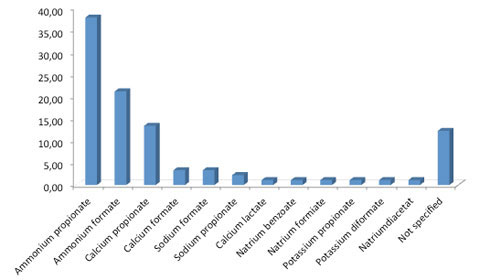
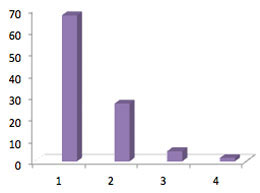
In the analysed products included in this study, other ingredients – for example, glycerine vegetable oils, benzaldehyde, etc. – are included. A list of other ingredients used for the supplementation to organic acid–based products is shown in table 1. The most popular ones used (more than three per cent) are inorganic acids, minerals and vitamins, essential oils, antioxidants, formaldehyde, glycerine, saccharides and betaine.
| Table 1. Other ingredients used in organic acid–based products | |
| Ingredients used in organic acid based products | |
|---|---|
| >3 per cent | Inorganic acids, minerals and vitamins, essential oils, antioxidants, formaldehyde, glycerine, saccharides, betaine |
| <3 per cent | Amino acids, mono- and diglycerides, aroma, vegetable oils, salts of inorganic acids, yeasts, clay minerals, propylene glycol, bacteria |
| <1 per cent | Glucose, sweetener, diatomite, choline, hexamine, benzaldehyde, saponins, fungus, biotine, enzymes, probiotics, protein |
Figure 5 shows that, in almost 18 per cent of the acid–based products included in this study, inorganic acids are included. Mainly phosphoric acid was used. Other inorganic acids available for animal nutrition include sulphuric and hydrochloric acids. Inorganic acids dissociate completely and have, therefore, on one hand, a strong effect on pH and on the other hand, inorganic acids are not able to enter the bacterial cell wall. Therefore, the antibacterial effect, which can be seen when including inorganic acids to an animal’s diets derives from their ability to lower pH in feed and the gastrointestinal tract.
Furthermore, inorganic acids might result in a bitter taste of the diet, thus lowering feed consumption. Another observed adverse effect is the disruption of the animal’s metabolism due to the influx of anions. Thus, it is less surprising, that inorganic acids were applied into animal feed with different degrees of agreement. Some research has resulted in severe growth depression in weaning piglets due to the addition of hydrochloric or sulphuric acid in the pigs’ diet. Effects seen by the usage of phosphoric acids are contradictory, despite a proven pH reduction. However, later research reported comparable growth benefits in piglets for supplementation with fumaric acid and a phosphoric acid-based product immediately after weaning.
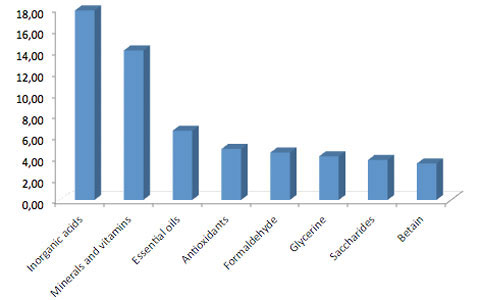
In almost 15 per cent of the products used in the current investigation, minerals and vitamins were supplemented. Most popular minerals used, are besides sodium (approximately 29 per cent) and potassium (approximately 34 per cent) copper (approximately 24 per cent) and zinc (19.5 per cent; Figure 6). When vitamins are included in a product, usually vitamin C (around 22 per cent) is used. However, in some products, vitamin B (4.9 per cent) and vitamin D3 (2.4 per cent) are also included. Commonly, only one (58.5 per cent) or sometimes two different minerals or vitamins (around 29 per cent) are substituted to the acid–based products. In some cases, more than three (around 12 per cent) different vitamins and minerals are included in a product as shown in Figure 7. However, in none of the products investigated in this study included more than five different minerals and vitamins.
Sodium and potassium are involved in nutrient transfer across cell membranes, body pH regulation, water balance and digestion.
Copper is often added at high levels as an inexpensive way to promote growth. It is important for many physiological functions, including iron metabolism, immunity and protection of tissues from oxidative stress. However, concerns raise due to the usage of high levels of copper, especially on older pigs diets as this can result in a build–up of copper in the soil on which the manure of pigs fed high levels of copper are fed.
Zinc, in general, is required by the animal for normal epidermal tissue development and proper function of several metabolic enzymes. Zinc was shown to reduce the incidence of diarrhoea and increases weight gain especially in young pigs. But excess zinc added to the animals’ diets can also result in an increase in zinc excreted and negative impacts on the environment. Another negative effect deriving from feeding high amounts of copper in older pigs is that it increases the amount of unsaturated fat, which results in softer pork fat.
Vitamin C plays an important role in the functionality of the immune system. It is believed to have beneficial effects especially during periods of stress. However, the body’s ability to store vitamin C is limited and excessive concentrations of vitamin C metabolites are excreted via urine. There is only limited evidence suggesting that supplemental vitamin C has beneficial effects during stress especially in pigs, but also in chickens.
However, in general it has to be kept in mind that the amount of nutrient excreted is directly related to the concentration of the nutrient in animal feed. Therefore, it is important not only due to environmental concerns to formulate the animals’ diets as close to their requirements as possible. Furthermore, the diets should be designed to prevent additional excretion of nutrients to avoid unnecessary costs by wasting nutrients through excessive supplementation. Furthermore, high dietary mineral levels result in an increased buffer capacity, thus reducing levels of free hydrochloric acid. Pepsin activation and pancreatic enzyme secretion are reduced, impairing nutrient digestion. Therefore, a lower buffering capacity is more beneficial as it results in positive effects on feed digestion.
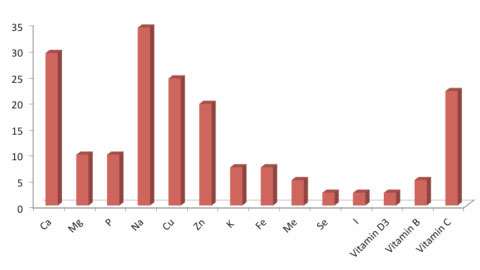

About 6.5 per cent of the organic acid–based products analysed in the current study contained essential oils. Combining essential oils and organic acids becomes more and more popular due to the improvement of the anti-microbial effect of these agents. Organic acids are particularly active in feed and the upper part of the gastrointestinal tract, whereas essential oils exert their action in the later segments of the intestinal tract. Thus, the combination of both organic agents (organic acids and essential oils) results in a more efficient product due to providing beneficial influences throughout the whole gastrointestinal tract. Synergistic effects were found due to combining organic acids and essential oils resulting in improved feed conversion and improved average daily gain in poultry as well as pigs. In fact, effects found on animal performance were not only of additive but more of a synergistic nature. These synergistic effects between both products allow an even further reduction of inclusion level of organic acids and essential oils reducing additional feed costs. Furthermore, combining organic acids and essential oils can not only provide protection against harmful bacteria within the whole intestinal tract. Acids still remain active in feed, lowering its pH and, therefore, keeping the uptake of harmful bacteria low.
In 5.2 per cent of the products included in the study, antioxidants like butylhydroxytoluol (BHT), butylhydroxyanisol (BHA) and ethoxyquin are included. Antioxidants inhibit fatty acid oxidation and formation of peroxide free radicals. If a reactive molecule contains one or more unpaired electrons, the molecule is classified as being free radicals, which have the potential to damage cells and tissues. Furthermore, they protect feed sources against the destruction of vitamins especially vitamin A and E. Vitamin A functions in growth of skeletal and soft tissues of the body and vitamin E plays a role in the functioning of the immune system, as challenge to the animal by any disease process triggers an immune reaction. Such a reaction requires adequate levels of vitamin E, which are consumed in the process.
Formaldehyde has been used as an antimicrobial feed additive and was shown to reduce Salmonella and E. coli counts in feed. However, it remains unclear if the recontamination of feedstuff by Salmonella can be prohibited. Furthermore, it has been demonstrated, that the occurrence of Salmonella can be reduced by formaldehyde, but proof if formaldehyde also reduces Salmonella in animals is scarce. However, already the organic acids themselves have been proven to be effective in combating Salmonella.
Glycerine or glycerol is a by-product of biofuel production and may be used as an energy source. However, research found, that there is a considerable amount of variability in the composition of glycerine available at the market. Furthermore, glycerine has to be included in diets at high levels to see positive effects on growth performance. It was also shown, that for pigs, the energy value of crude glycerol is less than the energy value of vegetable oils. However, energy value of glycerol may also be depending on glycerol purity. Furthermore, it was shown, that effects of glycerol on growth performance can only be seen at very high inclusion levels.
Research has shown that saccharides can be potential immunomodulatory agents and improve health and immune function. The improved immune function is definitely an advantage of the inclusion of saccharides into animals’ feed. However, due to the lower pH and the bacteria reducing effect in feed and the gastrointestinal tract tract, when feeding acidifier products the immunological challenge for the animal is generally reduced.
Betaine acts as an osmolyte in vertebrate species and as a methyl donor, thus reducing the requirements for other methyl donors such as methionine and choline. However, studies on the dietary betaine effect on the performance of poultry and pigs are contradictory as in some experiments betaine supplementation improved daily gain whereas in other studies, betaine had no effect. The effects which might be seen by including betaine to a diet might like with glycerine be a matter of the source of betaine.
The overview of some acidifier products currently available on the market clearly demonstrates the importance of acidifiers on the market. Obviously, quite a lot of work went into making acidifying products more powerful and using possible synergistic effects by including various other substances. However, it is noteworthy that real synergistic effects are achieved by combining acid–based products with substances with a different mode of action or a different site of action. Furthermore, possible antagonistic effects have to be ruled out when combining organic acids with other substances, otherwise, economical benefits might be put on jeopardy.
March 2012








